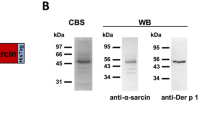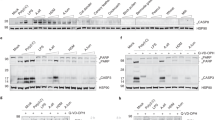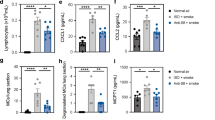Abstract
Atopic allergy is characterized by an increase in IgE antibodies that signal through the high-affinity Fcε receptor (FcεRI) to induce the release of inflammatory mediators from mast cells. For unknown reasons, the prevalence of allergic diseases has recently increased steeply in the developed world1. However, this increase has not been mirrored in developing countries2, even though IgE concentrations are often greatly elevated in individuals from these countries, owing to nonspecific IgE induction by universally present parasitic worms3. Here we offer one explanation for this paradox based on the properties of ES-62, a molecule secreted by filarial nematodes4. We found that highly purified, endotoxin-free ES-62 directly inhibits the FcεRI-induced release of allergy mediators from human mast cells by selectively blocking key signal transduction events, including phospholipase D–coupled, sphingosine kinase–mediated calcium mobilization and nuclear factor-κB activation. ES-62 mediates these effects by forming a complex with Toll-like receptor 4, which results in the sequestration of protein kinase C-α (PKC-α). This causes caveolae/lipid raft–mediated, proteasome-independent degradation of PKC-α, a molecule important for the coupling of FcεRI to phospholipase D and mast cell activation. We also show that ES-62 is able to protect mice from mast cell–dependent hypersensitivity in the skin and lungs, indicating that it has potential as a novel therapeutic for allergy.
This is a preview of subscription content, access via your institution
Access options
Subscribe to this journal
Receive 12 print issues and online access
$209.00 per year
only $17.42 per issue
Buy this article
- Purchase on Springer Link
- Instant access to full article PDF
Prices may be subject to local taxes which are calculated during checkout




Similar content being viewed by others
References
Burney, P.G.J. Epidemiological trends. in Asthma (eds. Barnes, P.J., Grunstein, M.M., Leff, A.R. & Woolcock, A.J.) 35–47 (Lippincott Raven, Philadelphia, 1997).
McKay, D.M. The beneficial helminth parasite? Parasitology 132, 1–12 (2006).
Wilson, M.S. & Maizels, R.M. Regulation of allergy and autoimmunity in helminth infection. Clin. Rev. Allergy Immunol. 26, 35–50 (2004).
Harnett, W., McInnes, I.B. & Harnett, M.M. ES-62, a filarial nematode-derived immunomodulator with anti-inflammatory potential. Immunol. Lett. 94, 27–33 (2004).
Kinet, J.P. The high-affinity IgE receptor (FcεRI): from physiology to pathology. Annu. Rev. Immunol. 17, 931–972 (1999).
Lal, R.B., Paranjape, R.S., Briles, D.E., Nutman, T.B. & Ottesen, E.A. Circulating parasite antigen(s) in lymphatic filariasis—use of monoclonal-antibodies to phosphocholine for immunodiagnosis. J. Immunol. 138, 3454–3460 (1987).
Melendez, A.J. & Khaw, A.K. Dichotomy of Ca2+ signals triggered by different phospholipid pathways in antigen stimulation of human mast cells. J. Biol. Chem. 277, 17255–17262 (2002).
Melendez, A.J., Harnett, M.M. & Allen, J.M. Crosstalk between ARF6 and protein kinase Calpha in FcγRI-mediated activation of phospholipase D1. Curr. Biol. 11, 869–874 (2001).
Li, G., Lucas, J.J. & Gelfand, E.W. Protein kinase Cα, βI and βII isozymes regulate cytokine production in mast cells through MEKK2/ERK5-dependent and independent pathways. Cell. Immunol. 238, 10–18 (2005).
Abdel-Raheem, I.T. et al. Protein kinase C-α mediates TNF release process in RBL-2H3 mast cells. Br. J. Pharmacol. 145, 415–423 (2005).
Coward, W.R. et al. NF-κB and TNF-α: a positive autocrine loop in human lung mast cells? J. Immunol. 169, 5287–5293 (2002).
Stassen, M. et al. IL-9 and IL-13 production by activated mast cells is strongly enhanced in the presence of lipopolysaccharide: NF-κB is decisively involved in the expression of IL-9. J. Immunol. 166, 4391–4398 (2001).
Jeong, H.J. et al. Role of Ca2+ on TNF-α and IL-6 secretion from RBL-2H3 mast cells. Cell. Signal. 14, 633–639 (2002).
Marquardt, D.L. & Walker, L.L. Dependence of mast cell IgE-mediated cytokine production on nuclear factor-κB activity. J. Allergy Clin. Immunol. 105, 500–505 (2000).
Dolmetsch, R.E., Xu, K. & Lewis, R.S. Calcium oscillations increase the efficiency and specificity of gene expression. Nature 392, 933–936 (1998).
Goodridge, H.S. et al. Immunomodulation via novel use of TLR4 by the filarial nematode phosphorylcholine-containing secreted product, ES-62. J. Immunol. 174, 284–293 (2005).
Rhee, S.H. & Hwang, D. Murine Toll-like receptor 4 confers lipopolysaccharide responsiveness as determined by activation of NF κB and expression of the inducible cyclooxygenase. J. Biol. Chem. 275, 34035–34040 (2000).
Powner, D.J., Hodgkin, M.N. & Wakelam, M.J. Antigen-stimulated activation of phospholipase D1b by Rac1, ARF6, and PKCα in RBL-2H3 cells. Mol. Biol. Cell 13, 1252–1262 (2002).
Leontieva, O.V. & Black, J.D. Identification of two distinct pathways of protein kinase Cα down-regulation in intestinal epithelial cells. J. Biol. Chem. 279, 5788–5801 (2004).
Li, L., Cousart, S., Hu, J. & McCall, C.E. Characterization of interleukin-1 receptor-associated kinase in normal and endotoxin-tolerant cells. J. Biol. Chem. 275, 23340–23345 (2000).
Smith, L. et al. Activation of atypical protein kinase Cζ by caspase processing and degradation by the ubiquitin-proteasome system. J. Biol. Chem. 275, 40620–40627 (2000).
Bryce, P.J. et al. Immune sensitization in the skin is enhanced by antigen-independent effects of IgE. Immunity 20, 381–392 (2004).
Goodridge, H.S. et al. Modulation of macrophage cytokine production by ES-62, a secreted product of the filarial nematode. Acanthocheilonema viteae. J. Immunol. 167, 940–945 (2001).
Nigo, Y.I. et al. Regulation of allergic airway inflammation through Toll-like receptor 4–mediated modification of mast cell function. Proc. Natl. Acad. Sci. USA 103, 2286–2291 (2006).
Bradding, P., Walls, A.F. & Holgate, S.T. The role of the mast cell in the pathophysiology of asthma. J. Allergy Clin. Immunol. 117, 1277–1284 (2006).
Hamelmann, E. et al. Noninvasive measurement of airway responsiveness in allergic mice using barometric plethysmography. Am. J. Respir. Crit. Care Med. 156, 766–775 (1997).
Harnett, W., Harnett, M.M. & Byron, O. Structural/functional aspects of ES-62—a secreted immunomodulatory phosphorylcholine-containing filarial nematode glycoprotein. Curr. Protein Pept. Sci. 4, 59–71 (2003).
McInnes, I.B. et al. A novel therapeutic approach targeting articular inflammation using the filarial nematode-derived phosphorylcholine-containing glycoprotein ES-62. J. Immunol. 171, 2127–2133 (2003).
Goodridge, H.S., Stepek, G., Harnett, W. & Harnett, M.M. Signalling mechanisms underlying subversion of the immune response by the filarial nematode secreted product ES-62. Immunology 115, 296–304 (2005).
Acknowledgements
This work was supported by grants from the YonH Loo Lin School of Medicine, the National University of Singapore (A.J.M.) and the Wellcome Trust (W.H. and M.M.H.).
Author information
Authors and Affiliations
Corresponding author
Supplementary information
Supplementary Text and Figures
Supplementary Methods and References, Supplementary Figs. 1–5 (PDF 4104 kb)
Rights and permissions
About this article
Cite this article
Melendez, A., Harnett, M., Pushparaj, P. et al. Inhibition of FcεRI-mediated mast cell responses by ES-62, a product of parasitic filarial nematodes. Nat Med 13, 1375–1381 (2007). https://doi.org/10.1038/nm1654
Received:
Accepted:
Published:
Issue Date:
DOI: https://doi.org/10.1038/nm1654
This article is cited by
-
Extracellular vesicles secreted by Brugia malayi microfilariae modulate the melanization pathway in the mosquito host
Scientific Reports (2023)
-
Orally desensitized mast cells form a regulatory network with Treg cells for the control of food allergy
Mucosal Immunology (2021)
-
The parasitic worm product ES-62 normalises the gut microbiota bone marrow axis in inflammatory arthritis
Nature Communications (2019)
-
IL-33/ST2 signalling and crosstalk with FcεRI and TLR4 is targeted by the parasitic worm product, ES-62
Scientific Reports (2018)
-
Small Molecule Analogues of the parasitic worm product ES-62 interact with the TIR domain of MyD88 to inhibit pro-inflammatory signalling
Scientific Reports (2018)



